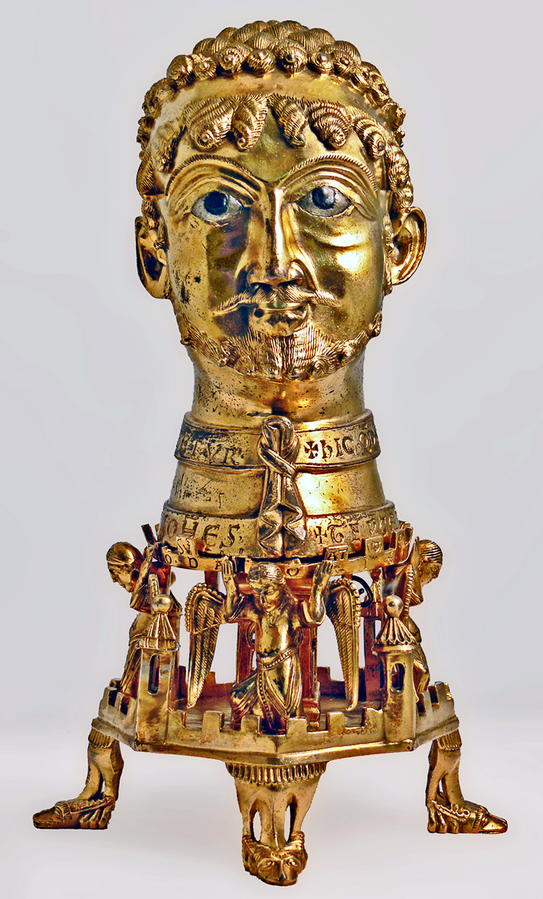Frederick Barbarossa takes the cross - 27 March, 1188.
On March 27, 1188, the Holy Roman Emperor Frederick I Barbarossa finally assented to go on crusade (the Third) and retake the Holy Land. Appeals to Frederick had begun in 1187 – firstly through letters sent to him by the various Crusader States asking for his assistance. On December 1st, Cadinal Henri de Marsaic (a former Cistercian Abbott) preached the crusade in Frederick’s presence in Strasbourg. On that occasion, Frederick had avoided taking the cross, especially because of his ongoing conflict with Philip, Archbishop of Cologne, one of his wealthiest lords but who had shown too much ambition.

A gilded bronze reliquary bust of Frederick, c. 1160.
Things had come to a head in 1184 when Philip had entered into negotiation with Pope Urban IV who was opposed to Frederick. In 1187 Philip defeated an Imperial army on its way to fight King Philip II of France. Frederick accused the archbishop of being unfaithful to him. It was at this juncture that he was encouraged to go on crusade – clearly he could not with a powerful lord and archbishop with territorial and political ambitions. On March 27, 1188, however, Philip and Frederick made up their differences at the Curia Christi in Mainz. This Diet had been called to settle what had become a major crisis within the Holy Roman Empire and one which needed resolving in order for Frederick to take up the cross and lead an army on the Third Crusade. The date was chosen carefully (it was the anniversary of Frederick’s coronation in 1152) and the peace between Philip and Frederick was declared by Cardinal Henri. Philip swore three oaths and agreed to pay a fine – he also agreed to partially destroy the walls of Cologne (which he had begun in 1180). With Philip’s submission to Frederick’s will (carefully organized that the diet was presided over not by Frederick but by Christ, as King over kings), the matter of the crusade was quickly brought up. A letter was read aloud to the assembly concerning the fall of Jerusalem and Bishop Godfrey of Würtzbug then preached a pro-crusade sermon. Frederick stood and (with an eye for the theatrical) asked the assembly if he should go to the aid of the Kingdom of Jerusalem. The crowd unanimously cried out that he should and Frederick ‘took the cross’ from Cardinal Henri. His example was followed by his second son, Duke Frederick Vi of Swabia, Duke Frederick of Bohemia, Duke Leopold V of Austria, Louis III of Thuringia and many of the bishops, lords and knights present. The Emperor’s eldest son, Henry VI, would remain behind as regent.
The army would assemble in April 1189, the time between would be used to organize the coming crusade down to the finest detail (a lesson learned from earlier, less well-prepared expeditions). Included in these preparations was Frederick sending notice to Saladin that their treaty of friendship (signed in 1175) was to be annulled. Promises of safe passage through Hungary, Serbia, Bulgaria and the Byzantine Empire were secured (some only after tough negotiating). The army set off – perhaps rising to as many as 100,000 troops (with 20,000 of them knights) – modern historians prefer to reduce this number by a factor of five (with a maximum f 20,000 men and 4,000 knights). The Army progressed, reaching Adrianople in Autumn 1189 and crossing into Anatolia in March 1190. The Crusade began successfully with victories in Anatolia at Philomelium and Iconium in May. Saladin broke of his siege of Acre to prepare for the crusaders arrival. Frederick was not to know that he would not live for much longer – on June 10, 1190, he drowned while crossing the Saleph River; various different versions of events were published soon after the event. What had started as the culminating triumph to a glorious reign was cut brutally short.

The Frederick Barbarossa Memorial, near Silifke, Mersin Province, southern Turkey. The text explains in Turkish and German how Frederick drowned nearby.


